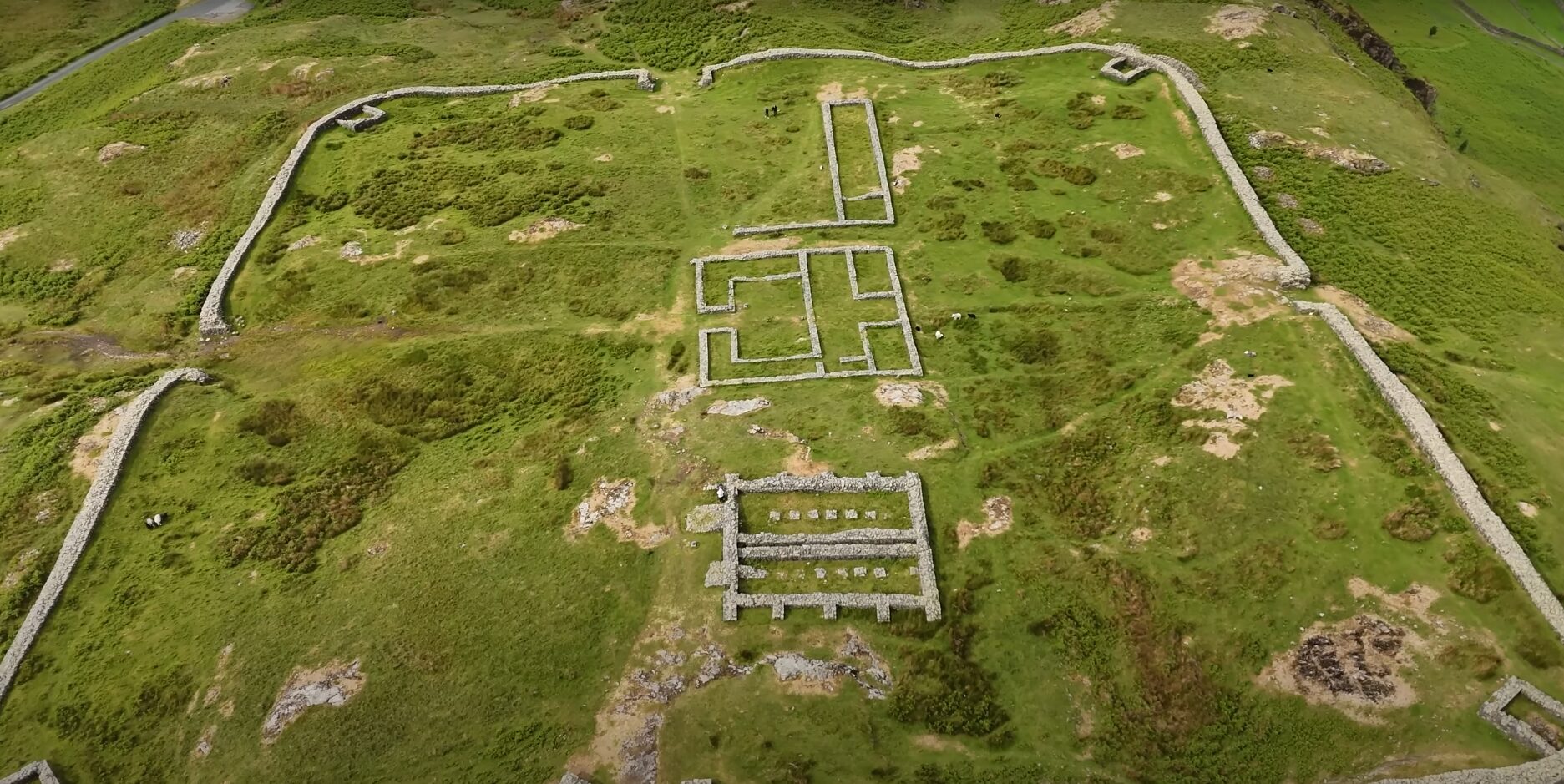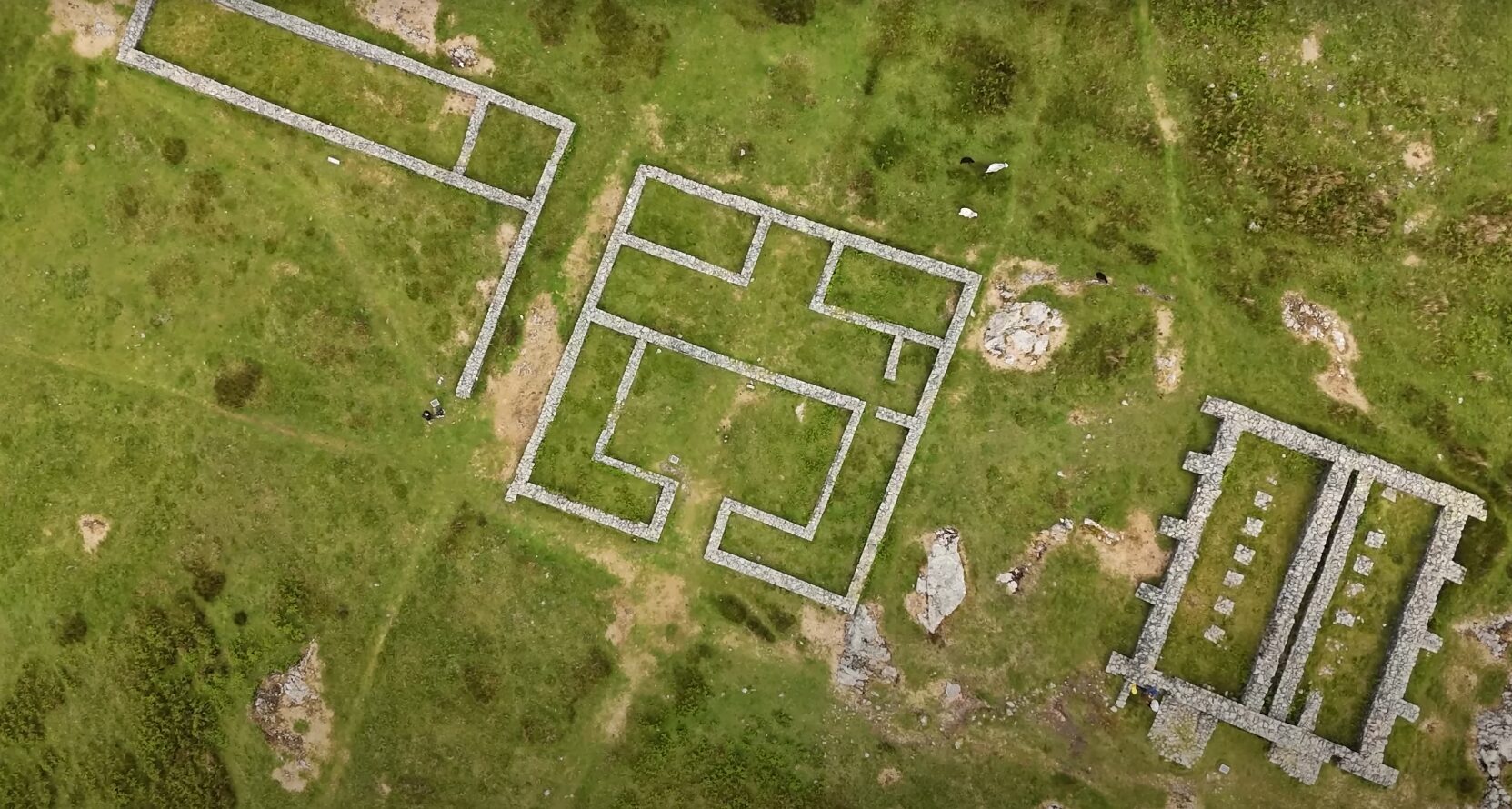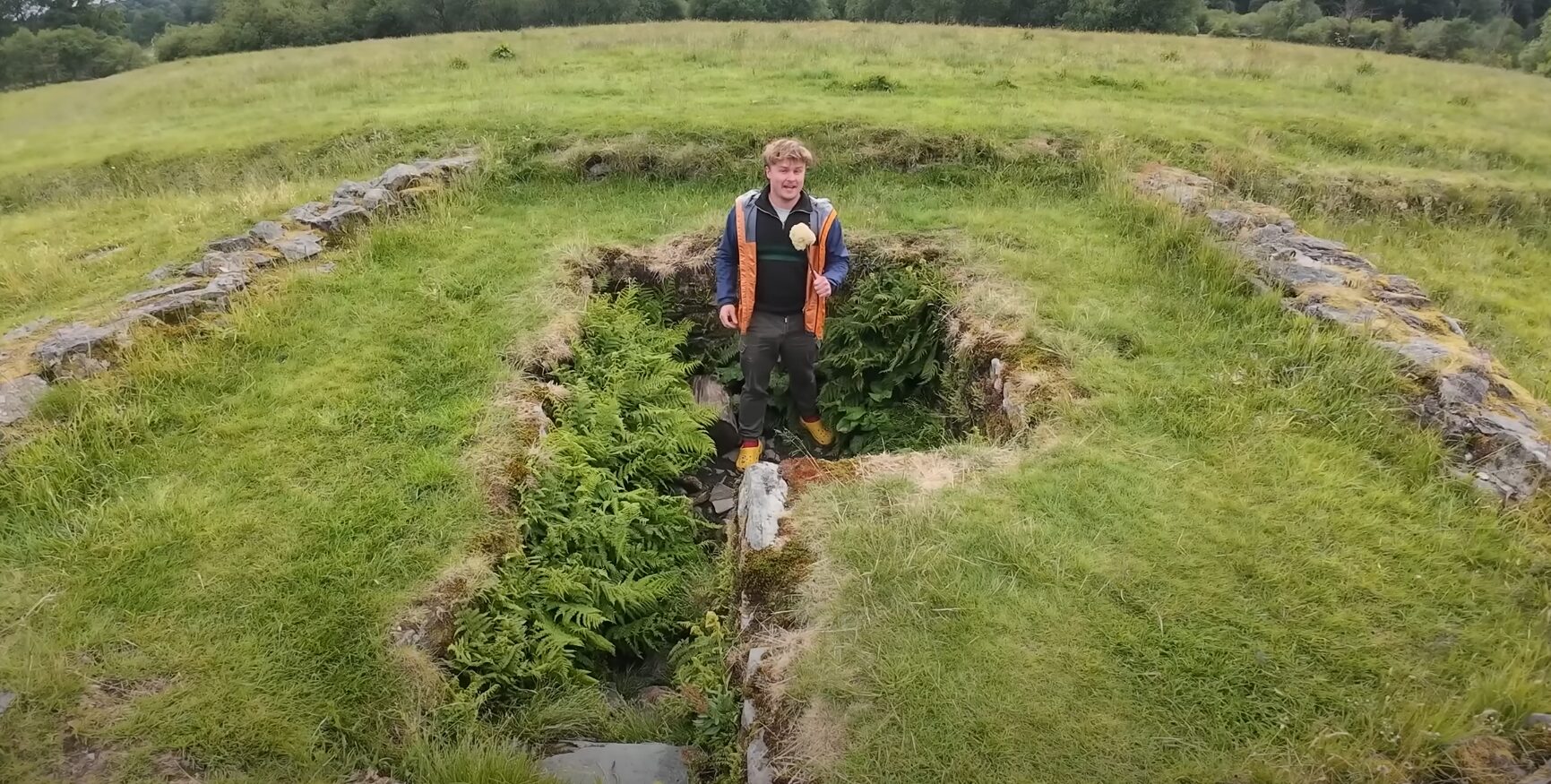High in the rugged hills of northwest England lies Hardknott Roman Fort, once a remote outpost of the Roman Empire. Built around 130 AD, it stood on a plateau overlooking steep valleys and mountain passes. The area’s harsh weather and isolation made it a difficult place to live, yet its position was vital for controlling movement through the Lake District and supporting Roman operations farther north.
The fort housed about 500 auxiliary soldiers, many from Dalmatia, far from their Mediterranean home. They trained, patrolled, and collected taxes from local herders who lived in the valleys below. Today, its ruins remain well preserved because few people settled here after the Romans left, leaving much of the original stonework intact.
Key Takeaways
- The fort occupied an isolated but strategic site in the Lake District.
- Soldiers from distant provinces maintained control and order in the region.
- Its preservation offers valuable insight into Roman military life and construction.
Location and Accessibility
Setting within the Lake District
Hardknott Roman Fort stands in the remote hills of northwest England, deep within the Lake District. The fort sits on a leveled plateau shaped by Roman engineers to create a flat surface for drills and daily routines. From this height, the surrounding valleys and peaks, including Scafell Pike, dominate the view. The area’s isolation helped preserve the fort’s stonework, as few later settlers reused its materials.
Key Site Features:
| Feature | Description |
|---|---|
| Elevation | Natural plateau modified for a flat base |
| Surroundings | Mountain valleys and open moorland |
| Visibility | Clear vantage over nearby passes |
| Preservation | Minimal later disturbance kept original walls intact |
Difficult Access to Hardknott Fort
Reaching the fort requires crossing steep, twisting mountain roads that remain challenging even today. The route includes sharp bends and long inclines that slow travel. The nearest settlement lies about 9 miles away in Ravenglass, showing how far the site is from populated areas.
Visitors often note how unpredictable weather—rain, cold winds, and fog—adds to the difficulty. These same conditions once tested the Roman soldiers stationed here, especially those brought from warmer parts of the empire like Dalmatia.
Access Summary:
- Terrain: narrow and steep mountain paths
- Distance: roughly 9 miles from Ravenglass
- Weather: frequent rain and low visibility
- Travel Tip: suitable only for careful drivers or hikers prepared for rough conditions
Historical Context of Roman Britain
Roman Campaign and Expansion
In 43 AD, Emperor Claudius ordered a large-scale invasion of Britain. Around 20,000 legionaries and an equal number of auxiliary soldiers landed to claim the island for Rome. Within a few decades, Roman control reached far into the north.
By 90 AD, the province was mostly under Roman rule. Governors built forts, roads, and supply routes to maintain control. The fort at Hardknott in the Lake District served as part of this network, linking mountain passes and supporting movement toward the frontier.
Key Points:
- Four legions led the invasion.
- Auxiliaries supported the legions in battle and garrison duties.
- Forts like Hardknott helped secure remote areas and manage local populations.
Retreat and Changing Borders
When pressure grew on the Empire’s mainland, Emperor Domitian withdrew one of Britain’s legions to defend continental territories. This shift forced Roman leaders to pull back from the far north and focus on more defensible lines.
The frontier later centered around Hadrian’s Wall, which marked a stable boundary between Roman-controlled lands and northern tribes. Forts such as Hardknott became vital for logistics and supply, not for direct combat.
| Period | Key Event | Impact on Britain |
|---|---|---|
| 43 AD | Roman invasion under Claudius | Start of Roman rule |
| 90 AD | Full control achieved | Expansion northward |
| Late 1st century | Troop withdrawal | Frontier moved south |
| Early 2nd century | Construction near Hadrian’s Wall | Stable northern border |
Roman forces at Hardknott included about 500 auxiliary soldiers, many from Dalmatia (modern Croatia). They lived far from home, trained daily on the fort’s parade ground, and maintained order in the valleys below.
Strategic Purpose of Hardnot Roman Fort
Function in Overseeing the Lake District
Hardnot Roman Fort stood in a remote valley surrounded by steep hills, giving soldiers a wide view of movement through the region. Its elevated position allowed the garrison to monitor travelers and local communities who lived by herding and small-scale farming. The fort’s presence discouraged resistance and ensured that taxes and supplies flowed toward Roman control.
Key aspects of its local role:
- Observation of mountain passes and valleys
- Enforcement of Roman taxation
- Deterrence of unrest among rural populations
Connection to Hadrian’s Wall
The fort supported the frontier system that developed along Hadrian’s Wall. By holding the mountain route open, Hardnot helped maintain communication and supply between the southern bases and the northern defenses. Its location made it a link in a chain of forts that backed the wall’s security and supported troop movement.
| Purpose | Description |
|---|---|
| Communication | Relayed messages and orders between outposts |
| Reinforcement | Provided troops when northern defenses needed support |
| Provisioning | Stored and distributed supplies for nearby garrisons |
Transport Routes and Army Supply
Hardnot Fort guarded a vital mountain road connecting the coast near Ravenglass with inland routes. This road allowed transport of food, weapons, and pay for soldiers stationed farther north. The garrison of about 500 auxiliary troops, mainly from Dalmatia, kept the route safe from theft or disruption.
Logistical features included:
- A controlled pass for moving goods through the mountains
- A flat, man-made parade ground used for drills and pay ceremonies
- Storage areas for supplies supporting frontier operations
Garrison and Daily Life
Structure of the Auxiliary Force
The fort held an auxiliary unit of about 500 soldiers. These men were not Roman citizens at first but earned citizenship after completing their service. The fort’s layout included a flat parade ground, shaped by the army to ensure level footing for drills and ceremonies. Soldiers trained, marched, and received their pay here four times a year. During those events, they wore full armor, displayed polished weapons, and gathered before the commander, who stood on a raised platform to lead the ceremony and perform religious rites.
| Activity | Frequency | Location | Purpose |
|---|---|---|---|
| Training and parades | Daily | Parade ground | Maintain discipline and readiness |
| Pay ceremonies | Four times a year | Tribunal platform | Distribute wages and perform rituals |
Enlistment from Dalmatia
The garrison came from Dalmatia, a Roman province in what is now Croatia. These soldiers were transferred far from home to avoid local ties and ensure loyalty to Rome. The contrast between their warm coastal homeland and the cold, wet climate of the Lake District made service here harsh. Yet they followed orders, guarding a remote valley and maintaining control over the mountain routes that supported supply lines to the frontier.
Military Tasks and Local Tax Control
The fort acted as a base for patrols and tax enforcement rather than a defensive fortress. Soldiers monitored the valleys and roads, ensuring that local herders and farmers paid their dues. Because the surrounding hills allowed locals to avoid taxation, the presence of the garrison reminded them of Roman authority. The troops’ duties included collecting taxes, keeping order, and protecting the routes that linked this isolated post to larger forts near Hadrian’s Wall.
Fort Architecture and Features
Elevated Ground and Leveled Terrain
The fort stood on a natural plateau that the Roman army reshaped to create a flat surface. They valued level ground for marching, building, and sleeping comfortably. The surrounding slopes were adjusted with careful earthwork so the soldiers could move and drill without uneven footing.
| Feature | Description |
|---|---|
| Terrain Type | Natural plateau, later leveled by Roman engineers |
| Purpose | Created stable ground for living quarters and drills |
| Benefit | Improved comfort, order, and military efficiency |
Training Field and Commander’s Platform
Beside the fort lay a large open field used daily for training and ceremonial duties. Soldiers practiced formations, drills, and received pay there four times a year. During these events, the commander stood on a raised platform to oversee the troops and conduct rituals to the gods. Aerial surveys reveal the clear outline of this leveled area and the remains of the platform.
Key activities included:
- Marching and weapons training
- Formal pay ceremonies
- Religious offerings before assemblies
Defensive Walls and Preservation
The stone walls of the fort remain visible because later settlers never reused the materials. The isolation of the site protected it from major rebuilding. The lower courses of the walls are original Roman work, while modern restorers added protective layers above them.
- The original walls once stood much taller.
- Some may have been coated with white plaster to make climbing harder.
- The fort served more as a base for patrols than as a fortress designed to resist siege.
This combination of strong construction, remote location, and minimal reuse has helped preserve the fort’s layout and materials for centuries.
Preservation and Archaeological Insights
Factors Behind Its Remarkable Condition
Hardknott Fort remains well-preserved because of its remote mountain setting. Later settlers never reused its stones, unlike other Roman sites where materials were taken for new buildings. The isolation prevented large-scale disturbance, leaving much of the structure in its original place.
| Condition | Reason |
|---|---|
| Walls mostly intact | Limited human activity |
| Minimal rebuilding | Lack of nearby settlement |
| Natural wear only | Exposure to wind and rain over centuries |
Modern Protection and Upkeep
Archaeologists and conservation teams have reinforced parts of the fort to prevent further damage. They added protective layers above the original stonework to mark where restoration begins. These efforts help preserve the authentic lower walls while showing visitors how the structure once looked.
Key conservation methods include:
- Stabilizing loose stones
- Marking original foundations with slate
- Preventing erosion from rain and vegetation
Building Materials and Design Choices
The fort’s walls were built from local slate and stone, shaped to fit the uneven ground. The Romans leveled the site to create a flat surface for marching and daily drills. Evidence suggests the walls may once have been coated with white plaster, possibly to make climbing harder and to reflect light.
| Material | Purpose |
|---|---|
| Local slate | Durable and readily available |
| Stone blocks | Main structural support |
| Possible plaster coating | Added protection and visibility |



